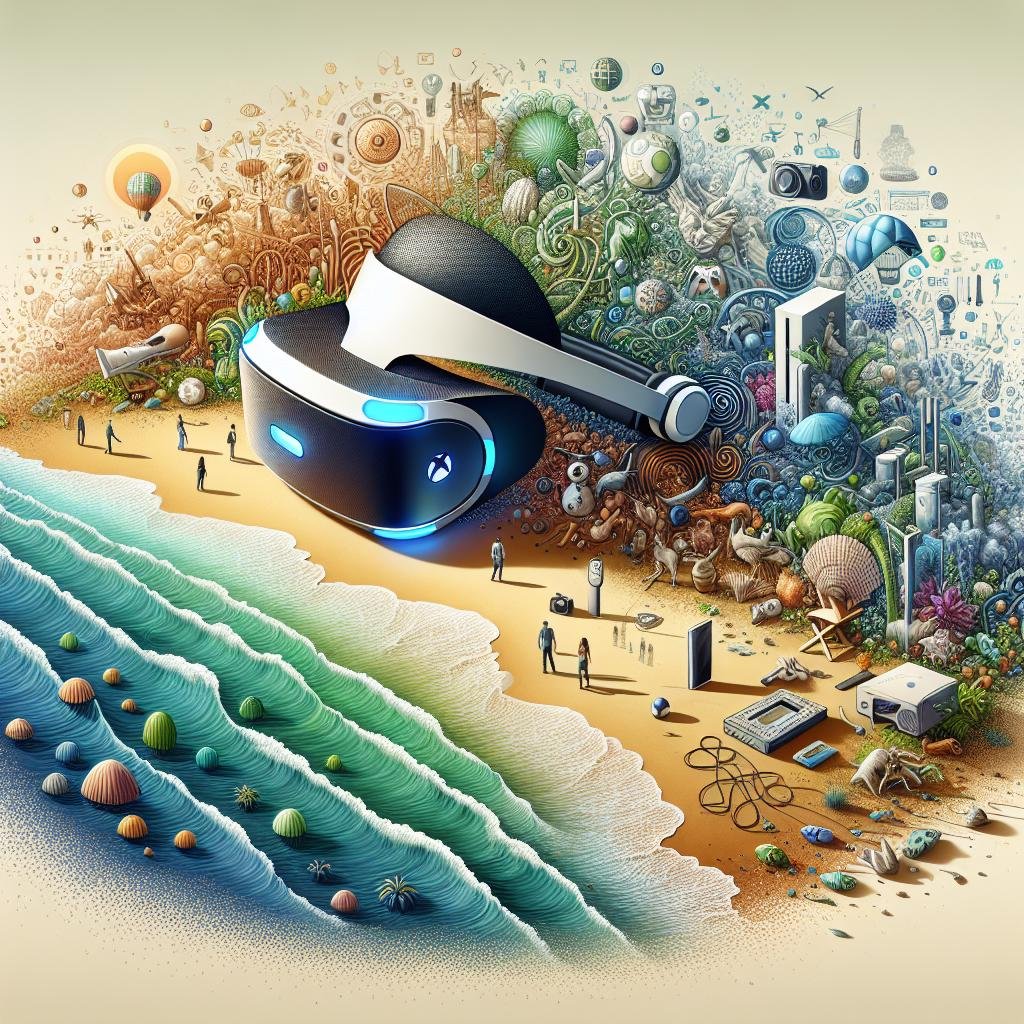Do VR Headsets Work with Xbox One? Unveiling the Virtual Reality Possibilities
In the ever-evolving world of gaming, virtual reality (VR) headsets have captured the imagination of players seeking an immersive experience like no other. But as an Xbox One owner, you might find yourself wondering, “Do VR headsets work with Xbox One?” It’s a question that belongs in the gamer’s FAQ, surrounded by curiosity and a hunger for more engaging gameplay adventures. In this article, we’ll delve into the compatibility of VR headsets with Xbox One, offering insight into how you can expand your gaming world with virtual reality technology. Whether you’re a casual player or a hardcore gamer, understanding the intersection of VR and Xbox One can transform the way you experience your favorite games. Let’s embark on this journey to discover what’s possible, and perhaps even inspire a whole new way to play.
Exploring Compatibility: Can You Use VR Headsets with Xbox One?
Understanding Xbox One and VR Compatibility
The question of whether VR headsets work with Xbox One is a hot topic among gaming enthusiasts. Although the Xbox One doesn’t natively support VR headsets, there are a few creative workarounds to explore. While you can’t directly plug in a VR headset like the Oculus Quest 2 and expect immediate compatibility, you can still bring a semblance of the virtual experience to your Xbox One. This can be achieved through methods like streaming your Xbox One games to a capable Windows PC, which can then cast your games onto a VR headset. However, this setup primarily focuses on making the display appear larger rather than creating a full 360-degree immersive environment.
If you’re eager to try this at home, here’s what you might need:
- Compatible PC: A Windows 10 PC with Xbox Companion App or Xbox Console Streaming setup.
- VR headset: Such headsets include Oculus Quest 2 or others compatible with streaming to PC.
- High-speed Wi-Fi: To ensure smooth streaming and reduce latency.
| Solution | Description |
|---|---|
| Stream to PC | Connect Xbox One to PC using Xbox Companion and access via VR headset. |
| Third-Party Apps | Use apps like Virtual Desktop for an expanded screen view. |
While there is no direct capability as of now, Xbox enthusiasts remain optimistic about potential updates that might allow seamless VR integration in future consoles. So, while you might be looking for direct usage, leveraging other technologies might just bring you closer to your ultimate gaming thrill.

Getting the Most Out of Your Xbox One Virtual Reality Experience
Enhancing Your Xbox One Experience with VR
For gaming enthusiasts looking for immersive experiences, combining your Xbox One with Virtual Reality (VR) can open new dimensions of interactive entertainment. Although Xbox One doesn’t natively support VR headsets out of the box, there are innovative ways to make it work. Consider using a third-party application that allows streaming from your console to your PC, which is compatible with VR headsets. This setup ensures you get the visual satisfaction of VR while harnessing the powerful hardware of your Xbox One.
- Ensure your VR headset is compatible with PC for better performance.
- Make use of applications like Xbox Console Companion or OneCast for streaming.
- Adjust your headset settings for optimal viewing and minimal latency.
Choosing the Right Setup for Your Needs
Before diving in, it’s important to select the appropriate equipment setup. Looking for the optimal mix can be overwhelming, but a streamlined approach can simplify the process. Here’s a quick comparison of popular options:
| Requirement | Option 1: High-End PC + VR | Option 2: Mid-Range PC + VR |
|---|---|---|
| Performance | Excellent | Good |
| Cost | Higher | Moderate |
Ultimately, pairing your Xbox One with a VR setup tailored to your needs makes for a gratifying gaming escapade. Whether you’re looking for ultrarealism or simply a better way to enjoy blockbuster titles, these options provide ample flexibility and enjoyment.

Top VR Headset Recommendations for Xbox One Users
Exploring VR Headsets Compatible with Xbox One
While the Xbox One doesn’t have built-in support for virtual reality like some other gaming consoles, certain VR headsets can still enhance your gaming experience. Here are some top recommendations that offer solid compatibility and immersive enjoyment:
- Oculus Rift S: Though it’s primarily designed for PC gaming, with a dedicated streaming app and some adjustments, you can mirror Xbox One gameplay to this headset, adding a dynamic visual component to your sessions.
- HP Reverb G2: Known for its high resolution and quality optics, it can stream Xbox One games through a network connection to a Windows 10 PC, delivering crisp imagery and smooth gameplay.
- Lenovo Explorer: A user-friendly option, this Mixed Reality headset can display Xbox games via a Windows PC with little technical hassle, perfect for those not wanting to invest too much time in setup.
Comparison of Recommended VR Headsets
| VR Headset | Resolution | Platform Compatibility |
|---|---|---|
| Oculus Rift S | 2560 x 1440 | PC with Xbox Streaming |
| HP Reverb G2 | 2160 x 2160 per eye | PC with Xbox Streaming |
| Lenovo Explorer | 1440 x 1440 per eye | PC with Xbox Streaming |
While you’re on this VR journey, it’s important to recognize that these headsets, although not directly compatible with Xbox One, bridge the gap through PC integration. This can offer gamers a taste of augmented playing environments. It’s all about harnessing additional technologies to enjoy the expansive worlds of Xbox games like never before. Always ensure to check connectivity details and game compatibility for the best experience.

Troubleshooting Tips for Seamless Integration of VR Headsets with Xbox One
Tips for Optimizing VR Headset Compatibility
Getting your VR headset to work seamlessly with Xbox One can sometimes be like trying to fit a square peg in a round hole. However, with a few clever tweaks and tech know-how, you can bridge the tech gap. Ensure your firmware is up-to-date; often, a simple update might resolve compatibility issues. Additionally, while not officially supported, some third-party solutions might offer limited functionality. What you need is a blend of patience and creativity—think out of the box and experiment cautiously with settings both on your console and VR headset. If things get tricky, check online communities & forums; they’re treasure troves of weird fixes others have tried successfully!
- Use adapters wisely and read reviews before buying third-party products.
- Check HDMI and USB port connections regularly to avoid disconnection issues.
- Explore AR-based applications with Xbox One as alternative immersive experiences.
Common Issues and Their Solutions
Just when you think you’re on the cusp of making your VR dreams come true, technical issues step in to shake up the experience. One common hiccup involves the display not synching properly—in this case, reboot both devices, and don’t forget to reset default settings if required. If you struggle with connectivity, remember, not every VR setup needs direct integration; streaming your console’s image onto a VR-ready device often does the trick. See below for a quick troubleshooting table that might just save the day:
| Issue | Potential Fix |
|---|---|
| Display Lag | Adjust Resolution, Check for Updates |
| No Audio | Inspect Audio Settings, Try Headphones |
| Intermittent Connection | Use High-Quality Cables |
Keeping an open mind and staying persistent are key to successfully integrating VR headsets with your Xbox One. You’re not just looking to fix issues—you’re opening portals to new worlds!
Q&A
Q: Can I use a VR headset with my Xbox One?
A: Great question! While Xbox One doesn’t natively support VR headsets out of the box, there are some nifty workarounds to get a basic VR experience. Ready to dive into the virtual realm? Let’s get going!
Q: What are my options if I want to use a VR headset with Xbox One?
A: Though Xbox One doesn’t offer built-in VR support, you can still enjoy a virtual spectacle. You might consider using the Xbox One in conjunction with a PC via apps that support streaming. And for full immersion, you can connect some headsets like the Oculus Rift or HTC Vive to stream Xbox games from a Windows 10 PC, thanks to their app integrations.
Q: How do these workarounds function?
A: Think of them as virtual screens! They don’t offer the interactive virtual environments seen in dedicated VR experiences, but you’ll see your games on a large virtual screen within a VR environment. This is handy if you’re looking for a cinematic feel without the immersive movements typically associated with VR gaming.
Q: Will any VR headset work with these methods?
A: Not exactly. While you can use headsets like the Oculus Rift via streaming applications, others like the PlayStation VR are designed specifically for their respective consoles or PCs. Compatibility can vary, so it’s always a good idea to check specific guides for your headset of choice.
Q: Why doesn’t Xbox One support VR natively?
A: Some think it’s all a matter of strategic priorities. Microsoft has focused on other innovations for Xbox, like Game Pass and Project xCloud. Meanwhile, the lack of native support keeps the system streamlined for what it excels at. However, there’s still hope that future Xbox consoles might embrace VR more robustly!
Q: So, should I purchase a VR headset to use with my Xbox One?
A: If you’re purchasing purely for VR functionality with Xbox One, you might want to hold off. However, if you already have a compatible headset or plan to use it for PC gaming as well, it might be worth exploring these workarounds. Remember, VR compatibility might enhance your gaming setup but won’t replace the cohesive VR game titles you’d typically find on dedicated systems.
And there you have it—a panoramic view of Xbox One’s VR landscape! While it might not be fully VR-ready just yet, who knows what the future holds? Keep your gamer spirit curious and your mind open to new tech horizons!
Wrapping Up
And there you have it—a comprehensive journey into the world of VR headsets and their compatibility with the Xbox One! Whether you’re an avid gamer ready to dive into the immersive worlds of virtual reality or a curious explorer peering through the digital looking glass, understanding the possibilities and limitations is the first step in leveling up your gaming experience. Remember, technology is constantly evolving, and while the Xbox One might currently have its limitations in the VR arena, the innovation landscape is as endless as your imagination. Stay tuned for future updates, and who knows, perhaps the next leap forward is just around the corner. Until then, keep gaming, dreaming, and exploring new worlds—virtual or otherwise. Game on!

